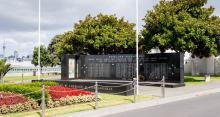“The St Nazaire Raid or Operation Chariot was a British amphibious attack on the heavily defended Normandie dry dock at St Nazaire in German-occupied France during the Second World War. The operation was undertaken by the Royal Navy (RN) and British Commandos under the auspices of Combined Operations Headquarters on 28 March 1942. St Nazaire was targeted because the loss of its dry dock would force any large German warship in need of repairs, such as Tirpitz, sister ship of Bismarck, to return to home waters by running the gauntlet of the Home Fleet of the Royal Navy and other British forces, via the English Channel or the North Sea.
The obsolete destroyer HMS Campbeltown, accompanied by 18 smaller craft, crossed the English Channel to the Atlantic coast of France and was rammed into the Normandie dock gates. The ship had been packed with delayed-action explosives, well hidden within a steel and concrete case, that detonated later that day, putting the dock out of service until 1948.
A force of commandos landed to destroy machinery and other structures. German gunfire sank, set ablaze, or immobilized virtually all the small craft intended to transport the commandos back to England. The commandos fought their way through the town to escape overland but many surrendered when they ran out of ammunition or were surrounded by the Wehrmacht defending Saint-Nazaire.
Of the 612 men who undertook the raid, 228 returned to Britain, 169 were killed and 215 became prisoners of war. German casualties included over 360 dead, some of whom were killed after the raid when Campbeltown exploded. To recognise their bravery, 89 members of the raiding party were awarded decorations, including five Victoria Crosses. After the war, St Nazaire was one of 38 battle honours awarded to the commandos. The operation has been called "the greatest raid of all" in British military circles.”
“Other naval units involved were two Hunt-class destroyers, HMS Tynedale and Atherstone, which would accompany the force to and from the French coast and remain out at sea during the raid. A motor gun boat (the Fairmile C type MGB 314) was the headquarters ship for the raid, with Commander Ryder and the commanding officer of the commandos on board. A motor torpedo boat (a 70 ft Vosper, MTB 74), commanded by Sub-Lieutenant Michael Wynn, (and Lt. Athol O’Connor, RNZNVR) had two objectives: If the outer Normandie dock gates were open, she had to torpedo the inner dock gates. If the gates were closed she would instead torpedo the gates at the old entrance into the St Nazaire basin.”
“The explosive charges in HMS Campbeltown detonated at noon on 28 March 1942, and the dry dock was destroyed. Reports vary on the fate of the two tankers that were in the dock; they were either swept away by the wall of water and sunk, or swept to the far end of the dock, but not sunk. A party of 40 senior German officers and civilians who were on a tour of Campbeltown were killed. In total, the explosion killed about 360 men. The wreck of Campbeltown could still be seen inside the dry dock months later when RAF photo reconnaissance planes were sent to photograph the port.
According to Captain Robert Montgomery (Royal Engineers, attached to No. 2 Commando), Campbeltown was meant to have detonated at 04:30, the delay caused, he believes, by some of the acid in the pencil detonators being distilled away. As the morning progressed, more and more captured comrades joined him in the German HQ.
Just before the Campbeltown exploded, Sam Beattie was being interrogated by a German naval officer who was saying that it wouldn't take very long to repair the damage the Campbeltown has caused. Just at that moment, she went up. Beattie smiled at the officer and said, 'We're not quite as foolish as you think!'
The day after the explosion, Organisation Todt workers were assigned to clean up the debris and wreckage. On 30 March at 16:30 the torpedoes from MTB 74, which were on a delayed fuse setting, exploded at the old entrance into the basin. This raised alarms among the Germans. The Organisation Todt workers ran away from the dock area. German guards, mistaking their khaki uniforms for British uniforms, opened fire, killing some of them. The Germans also thought that some commandos were still hiding in the town, and made a street by street search, during which some townspeople were also killed. (precis from Wikipedia)


